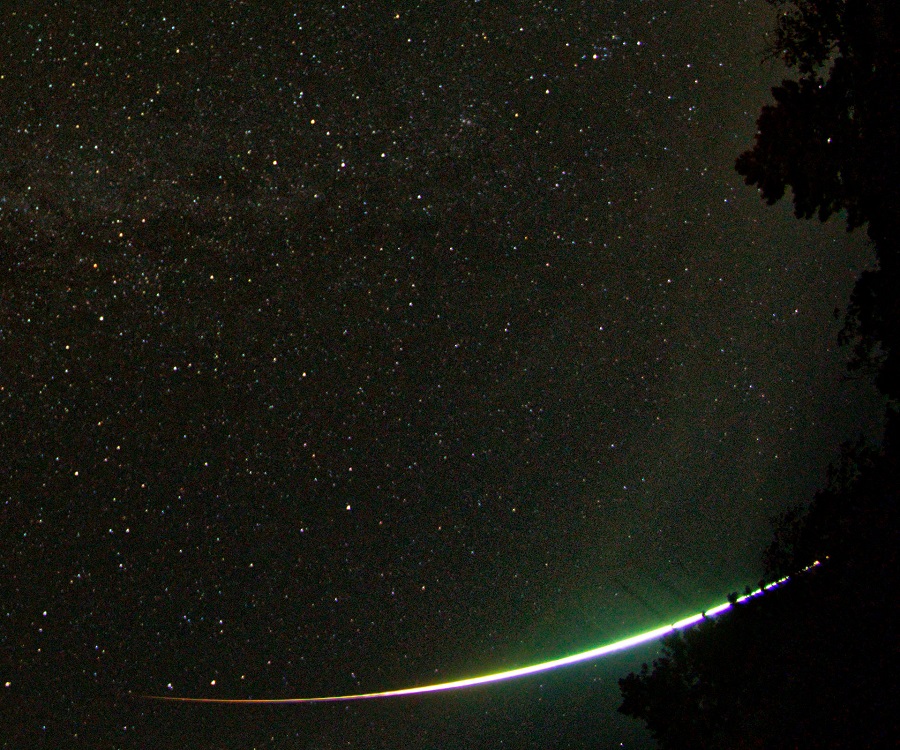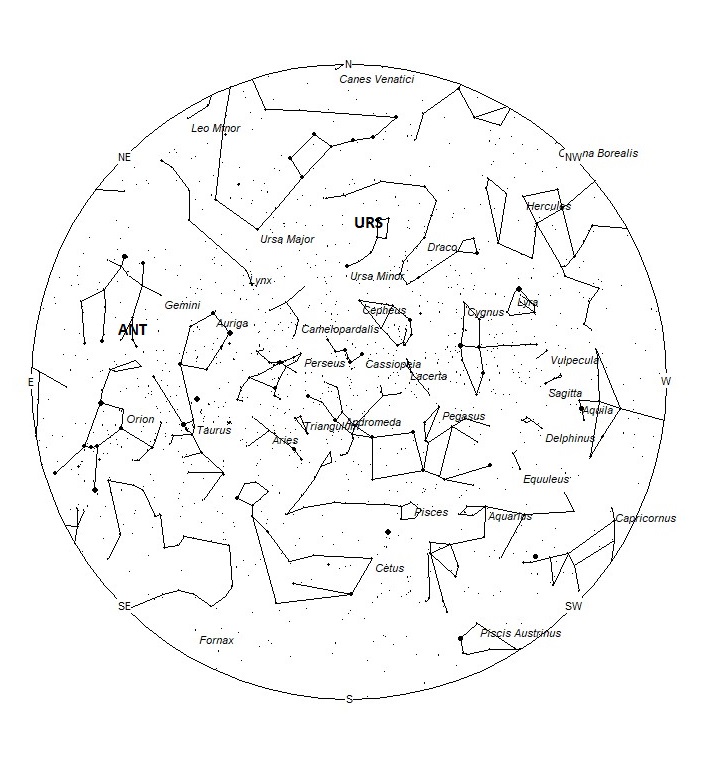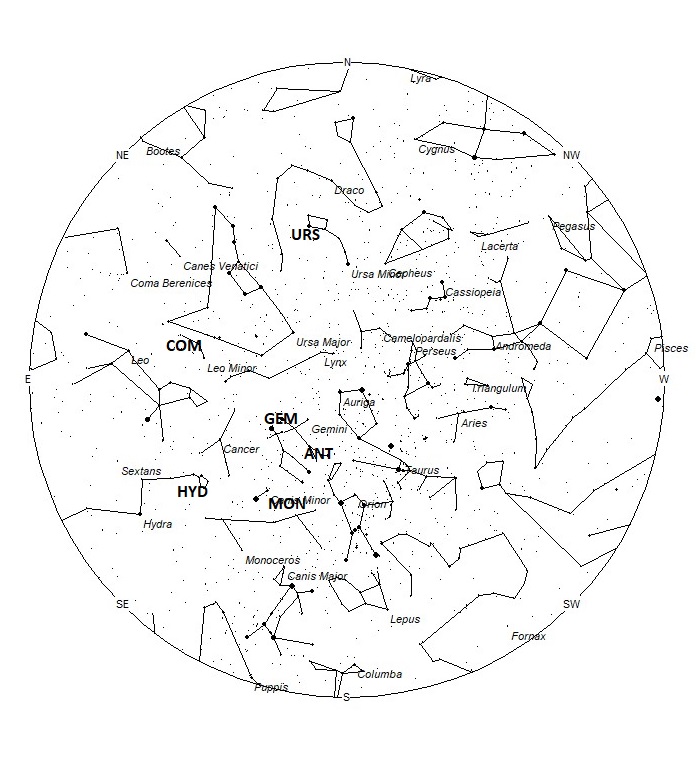 Nicolas Rossetto captured this colorful fireball at 00:20 UT on July 31, 2022 (2:20 CEST), from Saint-Thiébaud, Bourgogne-Franche-Comté, France. ©Nicolas Rossetto
Nicolas Rossetto captured this colorful fireball at 00:20 UT on July 31, 2022 (2:20 CEST), from Saint-Thiébaud, Bourgogne-Franche-Comté, France. ©Nicolas RossettoDuring this period, the moon reaches its new phase on Friday December 23rd. At that time the moon will lie near the sun and will be invisible at night. This weekend the waning crescent moon will rise during the early morning hours but should not interfere with meteor observing as long as you keep it out of your field of view. The estimated total hourly rates for evening observers this week should be near 4 as seen from mid-northern latitudes (45N) and 3 as seen from tropical southern locations (25S) For morning observers, the estimated total hourly rates should be near 20 as seen from mid-northern latitudes (45N) and 13 as seen from tropical southern locations (25S). The actual rates will also depend on factors such as personal light and motion perception, local weather conditions, alertness, and experience in watching meteor activity. Morning rates are slightly reduced due to moonlight during this period. Note that the hourly rates listed below are estimates as viewed from dark sky sites away from urban light sources. Observers viewing from urban areas will see less activity as only the brighter meteors will be visible from such locations.
The radiant (the area of the sky where meteors appear to shoot from) positions and rates listed below are exact for Saturday night/Sunday morning December 17/18. These positions do not change greatly day to day so the listed coordinates may be used during this entire period. Most star atlases (available at science stores and planetariums) will provide maps with grid lines of the celestial coordinates so that you may find out exactly where these positions are located in the sky. I have also included charts of the sky that display the radiant positions for evening, midnight, and morning. The center of each chart is the sky directly overhead at the appropriate hour. These charts are oriented for facing south but can be used for any direction by rotating the charts to the desired direction. A planisphere or computer planetarium program is also useful in showing the sky at any time of night on any date of the year. Activity from each radiant is best seen when it is positioned highest in the sky, either due north or south along the meridian, depending on your latitude. It must be remembered that meteor activity is rarely seen at the radiant position. Rather they shoot outwards from the radiant, so it is best to center your field of view so that the radiant lies at the edge and not the center. Viewing there will allow you to easily trace the path of each meteor back to the radiant (if it is a shower member) or in another direction if it is sporadic. Meteor activity is not seen from radiants that are located far below the horizon. The positions below are listed in a west to east manner in order of right ascension (celestial longitude). The positions listed first are located further west therefore are accessible earlier in the night while those listed further down the list rise later in the night.
These sources of meteoric activity are expected to be active this week.
.
Now that the activity from particles produced by comet 2P/Encke have ceased encountering the Earth, the Taurid showers for 2022 are over and we resume reporting activity from the Anthelion (ANT) radiant. This is not a true radiant but rather activity caused by the Earth’s motion through space. As the Earth revolves around the sun it encounters particles orbiting in a pro-grade motion that are approaching their perihelion point. They all appear to be radiating from an area near the opposition point of the sun, hence the name Anthelion. These were once recorded as separate showers throughout the year, but it is now suggested to bin them into a category separate from true showers and sporadics. This radiant is a very large oval some thirty degrees wide by fifteen degrees high. Activity from this radiant can appear from more than one constellation. The position listed here is for the center of the radiant which is currently located at 06:36 (099) +23. This position lies in central Gemini, 2 degrees southwest of the 3rd magnitude star known as Mebsuta (epsilon Geminorum). This radiant is best placed near 01:00 local standard time (LST) when it lies on the meridian and is highest in the southern sky. Rates at this time should be near 3 per hour as seen from the northern hemisphere and 2 per hour as seen from south of the equator. With an entry velocity of 30 km/sec., the average Anthelion meteor would be of slow velocity.
The Monocerotids (MON) become active this week from a radiant located at 07:08 (107) +07. This area of the sky is located in northern Monoceros, 4 degrees southwest of the 3rd magnitude star known as Gomeisa (beta Canis Minoris). This radiant best placed near 0100 LST, when it lies highest in the southern sky. Rates should be near 1 per hour no matter your location. With an entry velocity of 41 km/sec., most activity from this radiant would be of medium speed. This shower is active from December 5-20, with maximum activity occurring on December 9th.
The Geminids (GEM) are active from December 4-20, peaking on December 14th. The radiant currently lies at 07:44 (116) +32. This area of the sky lies in northwestern Gemini, just east of the 2nd magnitude star known as Castor (alpha Geminorum). These meteors are best seen near 02:00 LST, when the radiant lies highest in the southern sky. Rates are expected to be near 4 per hour as seen from the Northern Hemisphere and 2 as seen from south of the equator. With an entry velocity of 35km/sec, most of these meteors would appear to possess a medium velocity.
The sigma Hydrids (HYD) are active from a radiant located at 08:53 (133) +00. This area of the sky is located in western Hydra, 4 degrees southeast of the 4th magnitude star known as eta Hydrae. These meteors are active from November 24 through January 7th, with maximum activity occurring on December 7th. These meteors are best seen near 03:00 LST, when the radiant lies highest in the southern sky. Rates should be less than 1 per hour no matter your location. With an entry velocity of 58km/sec, most of these meteors would appear swift.
The Comae Berenicids (COM) are a long duration shower active from December 5th through February 4th. Maximum activity occurs on December 16th. The radiant is currently located at 10:38 (160) +32, which places it in Leo Minor, 4 degrees southwest of the faint star known as 46 Leonis Minoris. These meteors would be best seen near 04:00 LST, when the radiant lies highest in the eastern sky. Current rates would be near 2 per hour as seen from the Northern Hemisphere and 1 as seen from south of the equator. At 64km/sec., these meteors would produce mostly swift meteors. These meteors are also known as the December Leonis Minorids.
The Ursids (URS) are active from December 13-24 and peak on the morning of December 22nd. The radiant is currently located at 14:28 (217) +76. This area of the sky is located in southwestern Ursa minor, near the spot occupied by the 4th magnitude star known as 5 Ursae Minoris. This area of the sky is best seen during the last hour before dawn when it lies highest in the northern sky. Current rates are expected to be less than 1 no matter your location. This will increase to 5-10 meteors per hour on the morning of December 22nd for observers in the Northern Hemisphere. These meteors are not visible from the Southern Hemisphere. At 35 km/sec. this source would produce mostly medium speed meteors.
Sporadic meteors are those meteors that cannot be associated with any known meteor shower. All meteor showers are evolving and disperse over time to the point where they are no longer recognizable. Away from the peaks of the major annual showers, these sporadic meteors make up the bulk of the activity seen each night. As seen from the mid-Northern Hemisphere (45N) one would expect to see during this period approximately 9 sporadic meteors per hour during the last hour before dawn as seen from rural observing sites. Evening rates would be near 3 per hour. As seen from the tropical Southern latitudes (25S), morning rates would be near 7 per hour as seen from rural observing sites and 2 per hour during the evening hours. Locations between these two extremes would see activity between these listed figures. Evening rates are reduced during this period due to moonlight.
The list below offers the information in tabular form. Rates and positions are exact for Saturday night/Sunday morning except where noted in the shower descriptions.
| SHOWER | DATE OF MAXIMUM ACTIVITY | CELESTIAL POSITION | ENTRY VELOCITY | CULMINATION | HOURLY RATE | CLASS |
| RA (RA in Deg.) DEC | Km/Sec | Local Standard Time | North-South | |||
| Anthelions (ANT) | – | 06:36 (099) +23 | 30 | 00:00 | 3 – 2 | II |
| Monocerotids (MON) | Dec 09 | 07:08 (107) +07 | 41 | 01:00 | 1 – 1 | II |
| Geminids (GEM) | Dec 14 | 07:44 (116) +32 | 35 | 02:00 | 4 – 2 | I |
| sigma Hydrids (HYD) | Dec 09 | 08:53 (133) +00 | 58 | 03:00 | <1 – <1 | II |
| Comae Berenicids (COM) | Dec 16 | 10:38 (160) +32 | 64 | 05:00 | 2 – 1 | II |
| Ursids (URS) | Dec 22 | 14:28 (217) +76 | 33 | 07:00 | <1 – <1 | I |
Class Explanation: A scale to group meteor showers by their intensity:
- Class I: the strongest annual showers with Zenith Hourly Rates normally ten or better.
- Class II: reliable minor showers with ZHR’s normally two to ten.
- Class III: showers that do not provide annual activity. These showers are rarely active yet have the potential to produce a major display on occasion.
- Class IV: weak minor showers with ZHR’s rarely exceeding two. The study of these showers is best left to experienced observers who use plotting and angular velocity estimates to determine shower association. These weak showers are also good targets for video and photographic work. Observers with less experience are urged to limit their shower associations to showers with a rating of I to III.







 You saw something bright and fast? Like a huge shooting star? Report it: it may be a fireball.
You saw something bright and fast? Like a huge shooting star? Report it: it may be a fireball.  You counted meteors last night? Share your results with us!
You counted meteors last night? Share your results with us!  You took a photo of a meteor or fireball? You have a screenshot of your cam? Share it with us!
You took a photo of a meteor or fireball? You have a screenshot of your cam? Share it with us!  You caught a meteor or fireball on video? Share your video with us!
You caught a meteor or fireball on video? Share your video with us!